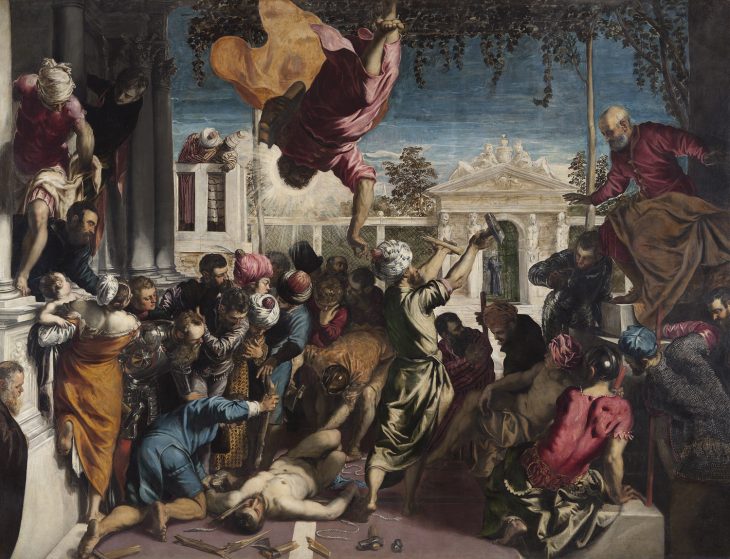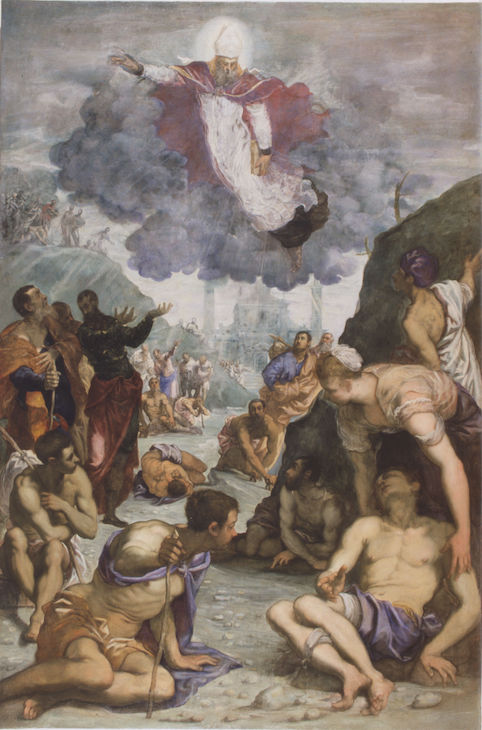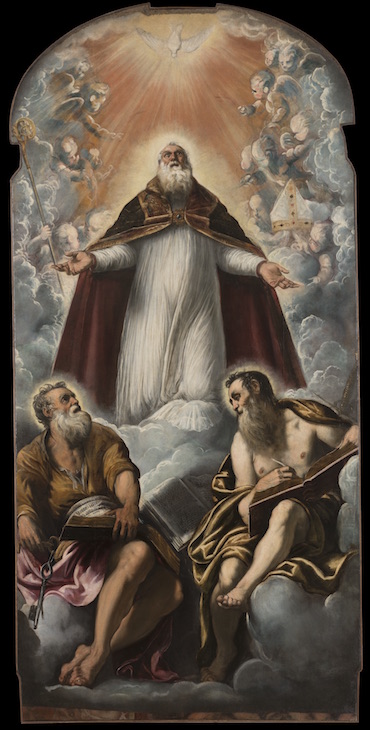Jacopo Tintoretto (c. 1519–94) had a bumpy start. Carlo Ridolfi, his 17th-century biographer, describes how the boy was apprenticed to Titian for mere days before the older artist expelled him from his studio in a fit of jealousy. Undaunted, Tintoretto taught himself by copying the finest artists of the day. To maintain focus, the youth inscribed on a wall: ‘Il disegno di Michelangelo e il colorito di Tiziano’ (the draughtsmanship of Michelangelo and the paint handling of Titian).
Although some scholars assume this account is apocryphal, the visual evidence of a fusion of Michelangelo and Titian seems persuasive in paintings from Tintoretto’s breakthrough moment, particularly The Miracle of the Slave (1548). Here the formula is embodied by muscular figures confidently drawn and an abundance of varied brushwork exploring the possibilities of oil. Tintoretto’s monumental Miracle was a watershed in Venetian art, sweeping away the measured narrative paintings of earlier generations. From that year on, any account of Venetian painting would need to accommodate Tintoretto’s outsized presence.
The Miracle of the Slave (1548), Jacopo Tintoretto. Gallerie dell’Accademia, Venice

In 2018–19, the 500th anniversary of Tintoretto’s birth is being celebrated particularly in Venice, where he was born and spent his entire career. Even if Venice honours the artist year-round at sites throughout the city, above all the Scuola Grande di San Rocco, this autumn the Palazzo Ducale hosts the first proper Tintoretto retrospective in the artist’s hometown since a massive exhibition at Ca’ Pesaro in 1937 (7 September–6 January 2019). For many decades it seemed that a Tintoretto exhibition was either unnecessary for Venice or impossible, given the large scale of many paintings and a persistent doubt over which works were actually by the master. The exhibition at the Palazzo Ducale, then travelling to the National Gallery of Art in Washington, D.C. (10 March–7 July 2019), hopes to dispel such reservations. Co-curator Robert Echols and I were privileged to assist Miguel Falomir in his landmark Tintoretto presentation at the Prado in 2007. The Madrid exhibition proved a museum setting could convey Tintoretto’s achievement through an up-to-date understanding of his oeuvre and chronology and a rigorous selection.
Saint Augustine Healing the Lame (c. 1549–50), Jacopo Tintoretto. Musei Civici, Pinacoteca di Palazzo Chiericati, Vicenza

At the Palazzo Ducale the mature career will be surveyed with superb loans of paintings and drawings, including famous works, such as The Origin of the Milky Way from London’s National Gallery, and the unjustly neglected. Building upon strengths in the Prado exhibition, emphasis will be given to the painter’s working methods as well as his portraiture, arguing that at his best, Tintoretto is one of the elite portrait painters of the 16th century. One crucial painting, however, will be missing: The Miracle of the Slave, which exemplifies better than any other the Michelangelo-Titian synthesis of the motto. Temporary exhibitions regularly face limitations of loan availability and logistics. Some works are too fragile to travel and, in Tintoretto’s case, some of his greatest paintings are too large to move safely. One is The Miracle of the Slave, more than four by five metres. What to do when a key painting is unavailable?
Our answer is twofold. First, the masterpiece will be the focus of a concurrent exhibition in its home institution. The Accademia has organised ‘Young Tintoretto’, investigating the first decade of Tintoretto’s activity, up to the epochal Miracle of the Slave, in the context of his most influential contemporaries. Second, in the Palazzo Ducale and National Gallery of Art venues, several carefully chosen works from 1549 convey, albeit at a smaller scale, many qualities of the missing masterpiece. These include Saint Augustine Healing the Lame, where the array of nude bodies suggests Michelangelo’s Battle of Cascina, and a neglected altarpiece, Saint Martial in Glory, from Tintoretto’s parish church of San Marziale. This latter work has been considered a conservative combination of Michelangelesque poses and Titianesque drapery, indeed a step back from the innovations in The Miracle of the Slave. Yet until recently its appearance was impossible to judge; a restoration in the 1950s had intentionally applied a golden varnish to convey an ‘Old Master’ quality, compounding the disfigurement of earlier overpaints.
Saint Martial in Glory with Saints Peter and Paul (after conservation), 1549, Jacopo Tintoretto. Church of San Marziale, Venice; photo: Matteo De Fina, 2018

Anticipating the Tintoretto quincentenary, the American organisation Save Venice sponsored in 2017–18 the conservation of 18 paintings by the artist in Venice, including the San Marziale altarpiece. After cleaning, the painting emerged as a virtuoso performance, with muscular figures bathed in a brilliant illumination. Sure to be a highlight at both the Palazzo Ducale and National Gallery of Art, this work expresses the boldness of The Miracle of the Slave and also communicates a previously unrecognised aspect of Tintoretto’s art.
‘Tintoretto 1519–2019’ is at the Palazzo Ducale from 7 September–6 January 2019; it will travel to the National Gallery of Art in Washington, D.C. from 10 March–7 July 2019.
From the September issue of Apollo. Preview and subscribe here.


